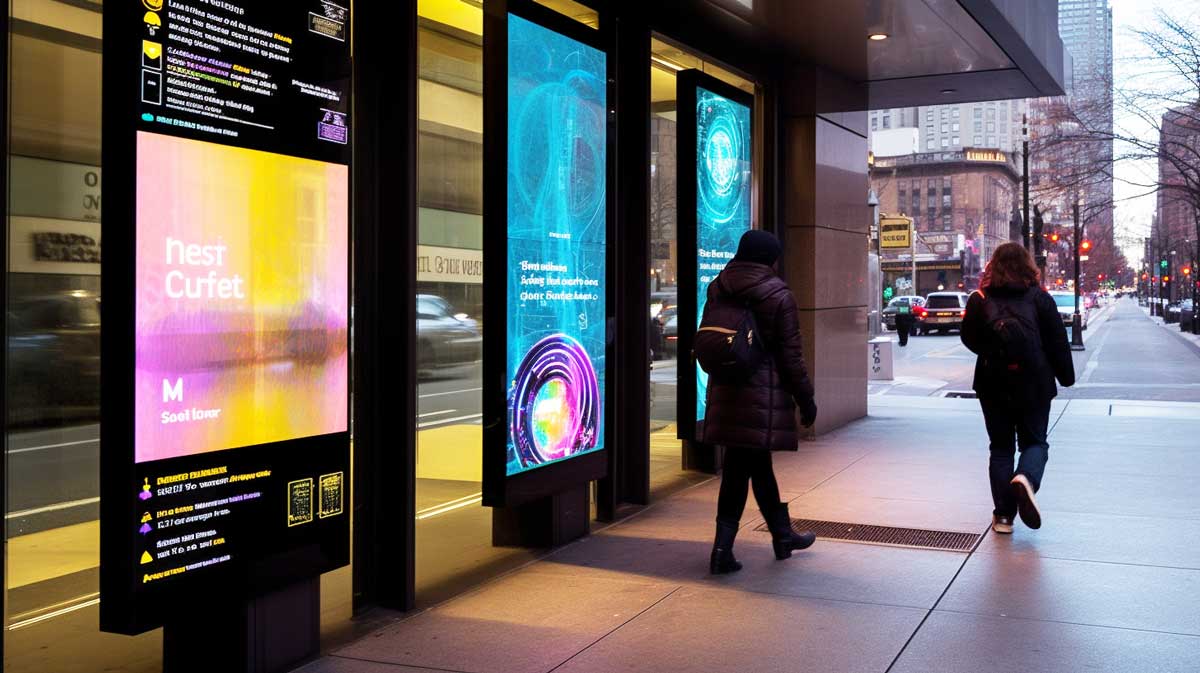The world of digital signage is rapidly evolving, with new technologies and applications popping up every day. From artificial intelligence (AI) to virtual reality (VR), the possibilities are endless when it comes to how we can use digital signage in 2023. As businesses look for more ways to engage customers, increase sales, and reach their target audiences, they’ll be turning to these innovative trends that will help them do just that. In this blog post, we’ll take a look at some of the most exciting digital signage trends you need to know about for 2023.
1. AI-powered Digital Signage
AI has become increasingly important in the digital signage industry, and for good reason. AI can be used to detect customer movement, analyze data, and optimize content in real time. This allows businesses to quickly adjust their digital signage displays and increase engagement with customers on a much more personal level.
By leveraging machine learning algorithms and natural language processing, AI can help users to create digital signage content like texts, images, or even movies in the near future. For instance, AI can analyze user data such as customer behavior, purchase history, and demographic information to create targeted and personalized content that resonates with the target audience. AI can also analyze user feedback and monitor industry trends to identify the most effective content strategies.
Moreover, AI can reduce time and costs associated with content creation by automating repetitive tasks such as image editing, text editing, and video editing. This will enable content creators to focus on more creative tasks such as ideation and strategy.
Furthermore, AI-powered analytics can help content creators to measure the effectiveness of their campaigns, track user engagement, and identify areas for improvement. For instance, AI can track user interactions with displays, such as click-through rates and dwell time, to determine the effectiveness of a particular display and optimize it for better results.

In conclusion, AI has the potential to revolutionize the digital signage industry by enabling users to create more targeted, personalized, and engaging content. With AI technology, content creators can automate repetitive tasks, track user engagement, and optimize their campaigns for better results. As AI continues to evolve, it can help the digital signage industry to reach new heights and drive faster growth.
AI-powered Digital Signage is revolutionizing the world of advertising and marketing. Here are some examples of how businesses are using this cutting-edge technology to enhance customer engagement and drive business growth.
Examples
- Personalized advertising: With AI-powered Digital Signage, businesses can create targeted advertising campaigns that cater to individual customer preferences and interests. By analyzing customer data, such as past purchases, website interactions, and search history, AI algorithms can generate personalized ads that resonate with customers, leading to higher conversion rates and customer loyalty.
- Real-time content: AI-powered Digital Signage allows for the creation of dynamic, real-time content that adapts to changing conditions and events. For example, a shopping mall could use AI to display current traffic conditions on its signage, guiding shoppers towards less congested areas. Similarly, an airline could use AI to display up-to-date flight information, guiding passengers to their gates and reducing confusion and delays.
- Interactive experiences: By incorporating advanced technologies like facial recognition, gesture control, and voice recognition, AI-powered Digital Signage enables businesses to offer engaging, interactive experiences to their customers. For example, a restaurant could use AI to allow customers to place their orders via voice commands, reducing wait times and increasing customer satisfaction.
- Smart analytics: AI-powered Digital Signage can generate detailed analytics that help businesses better understand their customers and improve their marketing strategies. By tracking customer interactions with signage and analyzing data such as time spent viewing ads, click-through rates, and demographic information, businesses can gain valuable insights into customer behavior and tailor their marketing efforts accordingly.
Overall, AI-powered Digital Signage is a powerful tool that provides businesses with unprecedented levels of customization, interactivity, and intelligence. By leveraging this technology, businesses can create compelling, tailored marketing experiences that drive customer engagement, loyalty, and growth.
2. Interactive Digital Signage
With the explosion of interactive displays in recent years, digital signage is no longer a one-way street. People can now interact with digital signage by using their smartphones or other devices to access information and promotions. This provides businesses with the opportunity to engage customers on a more personal level and increase sales.
Interactive digital signage provides an extra layer of engagement for customers compared to traditional non-interactive signage. The introduction of touchscreen technology has drastically improved the customer experience, making it more immersive and personalized to their needs. With interactive digital signage, customers can interact with the signage by swiping, tapping, or even speaking directly to the display.

In the retail industry, interactive digital signage can create a great customer experience by providing real-time information and product recommendations. For instance, imagine a clothing store with an interactive digital signage display that matches clothing items to a customer’s preferences by scanning their body. The display can then suggest items that fit the customer’s needs, size, and style preferences. Customers can learn more about the product and its features by interacting with the display. Furthermore, interactive digital signage can provide additional information such as reviews, promotions, and special offers.
Interactive digital signage can also be used as a digital salesman to enhance the sales process by providing customers with product information to make an informed purchase decision. For example, a car dealership can use interactive digital signage to showcase a car’s features and provide virtual test drives. This type of digital signage can help customers learn more about the product, allowing for questions and concerns to be addressed before making a purchase. This enhances sales without requiring an actual salesperson, reducing overhead costs while still delivering value to the customer.
Interactive digital signage is a powerful marketing tool that can provide a wide range of benefits to businesses. It improves the customer experience by providing personalized and immersive experiences, and can also act as a digital salesman, enhancing the sales process. With interactive digital signage, businesses can deliver a more engaging and fulfilling experience for their customers, resulting in greater customer satisfaction and ultimately repeat business.
3. Location-based Digital Signage
As technology advances, digital signage is becoming increasingly location-aware. This means that businesses can use digital signs to provide customers with tailored content based on their current location. For example, if a customer enters a store, they may be presented with promotional material tailored to the store’s products or services. In other words, this type of digital signage is designed to catch the attention of people passing by or in specific areas of a store or public space.
Location-based Digital Signage has a wide range of use cases, from advertising and marketing to information dissemination. For instance, retail stores can use this technology to display promotions, product information, store maps, or videos, which are specifically targeted to people close to the store. In airports, digital signage could display information about nearby restaurants, stores, and services, as well as flight information and directions.

Furthermore, public transportation systems can use location-based digital signage to provide relevant information to commuters about schedules, delays, and the location of the next vehicle. Museums and galleries can also leverage this technology to display information and engage visitors using interactive presentation and contextual videos.
In conclusion, location-based digital signage is an effective way to engage audiences and deliver targeted content in real-time. It allows businesses and organizations to tailor their messaging according to the specific location and preferences of their audience, enhancing the overall experience of the audience. With the expansion of location-based technology, the application of this digital signage technology will continue to grow in various industries, improving communication channels and overall customer satisfaction.
4. Cloud-based Digital Signage: Cloud-based digital signage solutions are becoming increasingly popular amongst businesses as they provide a cost-effective way to manage displays across multiple locations. With cloud-based digital signage, businesses can quickly and easily update content for their displays, ensuring that customers always have the latest information at their fingertips.
One of the primary contributors to this trend is our digital signage software-as-a-service viewneo, an intuitive and user-friendly platform that has taken the industry by storm. With cloud-based digital signage, businesses can easily manage and update their displays from anywhere in the world, without the need for costly on-site servers or technical expertise. This not only enhances the flexibility and efficiency of digital signage but also reduces the overall cost. The ease of use and accessibility of cloud-based digital signage solutions like viewneo have revolutionized the way businesses communicate with their customers and employees. This trend is showing no signs of slowing down, and it’s clear that cloud-based digital signage is here to stay.
By leveraging these digital signage trends in 2023, you can capitalize on the opportunity to create a more engaging and immersive customer experience. From AI-powered displays to cloud-based solutions, businesses have an array of options when it comes to creating an impactful digital signage strategy.
You just have to find the right solution for your needs.
Author: Manfred Lüdtke is a visionary leader and innovator in digital signage and smart technologies, specializing in creating user-centric solutions that drive digital transformation and enhance business operations.





